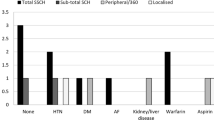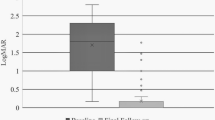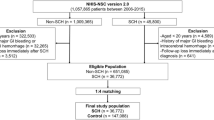Abstract
Purpose
The management of suprachoroidal haemorrhage (SCH) remains a challenge. We aimed to analyse and discuss the safety and efficacy outcomes of SCH drainage surgery over a 10-year period in one of the largest tertiary centres in the UK.
Methods:
Retrospective observational study of consecutive patients who underwent SCH drainage in Manchester Royal Eye Hospital over a 10-year period (from 2008 to 2018). Safety and efficacy were assessed by analysing surgery-related complications and functional and anatomical success. Outcomes of those who underwent external drainage alone versus combined drainage and vitrectomy were compared.
Results:
Twenty consecutive patients with a mean age of 70 ± 19 years were studied. Age over 70 years, hypertension, cardiovascular disease, and glaucoma were the most common risk factors for SCH. Eleven patients underwent external drainage alone and nine patients had combined vitrectomy and drainage. Overall, mean pre-operative BCVA improved from 2.22 ± 0.26 logMAR (20/3319 Snellen) to 1.42 ± 1.02 LogMAR (20/526 Snellen) at last follow-up visit (p = 0.002). Severe hypotony occurred in 4 patients. Overall anatomical and functional success rates were both 75%.
Conclusions
Drainage of SCH with or without vitrectomy is a valuable approach in the management of extensive SCH, a condition generally associated with poor prognosis.
Similar content being viewed by others
Log in or create a free account to read this content
Gain free access to this article, as well as selected content from this journal and more on nature.com
or
References
Laube T, Brockmann C, Bornfeld N. Massive suprachoroidal hemorrhage: Surgical management and outcome. GMS Ophthalmol Cases. 2015;5. https://doi.org/10.3205/oc000032
Eriksson A, Koranyi G, Seregard S, Philipson B. Risk of acute suprachoroidal hemorrhage with phacoemulsification. J Cataract Refract Surg. 1998;24:793–800.
Meier P, Wiedemann P. Massive suprachoroidal hemorrhage: secondary treatment and outcome. Graefes Arch Clin Exp Ophthalmol Albrecht Von Graefes Arch Klin Exp Ophthalmol. 2000;238:28–32.
Stein JD, Zacks DN, Grossman D, Grabe H, Johnson MW, Sloan FA. Adverse events after pars plana vitrectomy among medicare beneficiaries. Arch Ophthalmol Chic Ill 1960. 2009;127:1656–63. https://doi.org/10.1001/archophthalmol.2009.300
Ruderman JM, Harbin TS, Campbell DG. Postoperative suprachoroidal hemorrhage following filtration procedures. Arch Ophthalmol Chic Ill 1960. 1986;104:201–5.
Obuchowska I, Mariak Z. Risk factors of massive suprachoroidal hemorrhage during extracapsular cataract extraction surgery. Eur J Ophthalmol. 2005;15:712–7.
Ling R. Suprachoroidal haemorrhage complicating cataract surgery in the UK: epidemiology, clinical features, management, and outcomes. Br J Ophthalmol. 2004;88:478–80. https://doi.org/10.1136/bjo.2003.026138
Chandra A, Xing W, Kadhim MR, Williamson TH. Suprachoroidal hemorrhage in pars plana vitrectomy. Ophthalmology. 2014;121:311–7. https://doi.org/10.1016/j.ophtha.2013.06.021
Lavinsky F, Moisseiev J, Levkovitch-Verbin H. The surgical management of massive intraoperative and postoperative suprachoroidal hemorrhage: anatomic and functional outcomes. Arq Bras Oftalmol. 2013;76:212–4.
Speaker MG, Guerriero PN, Met JA, Coad CT, Berger A, Marmor M. A case-control study of risk factors for intraoperative suprachoroidal expulsive hemorrhage. Ophthalmology. 1991;98:202–9.
Agha RA, Borrelli MR, Farwana R, Koshy K, Orgill D, et al. The PROCESS 2018 statement: Updating Consensus Preferred Reporting Of CasE Series in Surgery (PROCESS) guidelines. Int J Surg Lond Engl. 2018;60:279–82. https://doi.org/10.1016/j.ijsu.2018.10.031
Lee JWY, Lai JSM, Yick DWF, Tse RKK. Retrospective case series on the long-term visual and intraocular pressure outcomes of phacomorphic glaucoma. Eye Lond Engl. 2010;24:1675–80. https://doi.org/10.1038/eye.2010.108
Kuhn F, Morris R, Mester V. Choroidal detachment and expulsive choroidal hemorrhage. Ophthalmol Clin N. Am. 2001;14:639–50.
Reynolds MG, Haimovici R, Flynn HW, DiBernardo C, Byrne SF, Feuer W. Suprachoroidal hemorrhage. Clinical features and results of secondary surgical management. Ophthalmology. 1993;100:460–5.
Lakhanpal V. Experimental and clinical observations on massive suprachoroidal hemorrhage. Trans Am Ophthalmol Soc. 1993;91:545–652.
Scott IU, Flynn HW, Schiffman J, Smiddy WE, Murray TG, Ehlies F. Visual acuity outcomes among patients with appositional suprachoroidal hemorrhage. Ophthalmology. 1997;104:2039–46.
Acknowledgements
This research was facilitated by the Greater Manchester Local Clinical Research Network.
Author information
Authors and Affiliations
Corresponding author
Ethics declarations
Conflict of interest
The authors declare that they have no conflict of interest.
Additional information
Publisher’s note Springer Nature remains neutral with regard to jurisdictional claims in published maps and institutional affiliations.
Supplementary information
Rights and permissions
About this article
Cite this article
Qureshi, A., Jalil, A., Sousa, D.C. et al. Outcomes of suprachoroidal haemorrhage drainage with and without vitrectomy: a 10-year study. Eye 35, 1879–1885 (2021). https://doi.org/10.1038/s41433-020-01170-w
Received:
Revised:
Accepted:
Published:
Issue date:
DOI: https://doi.org/10.1038/s41433-020-01170-w
This article is cited by
-
Perioperative suprachoroidal hemorrhage and its surgical management: a systematic review
International Journal of Retina and Vitreous (2024)
-
The Royal College of Ophthalmologists’ National Ophthalmology Database Study of Cataract Surgery: Report 12, Risk factors for suprachoroidal haemorrhage during cataract surgery
Eye (2023)
-
Clinical characteristics and mortality rates for suprachoroidal hemorrhage: seven-year experience at a tertiary eye center
Graefe's Archive for Clinical and Experimental Ophthalmology (2022)



